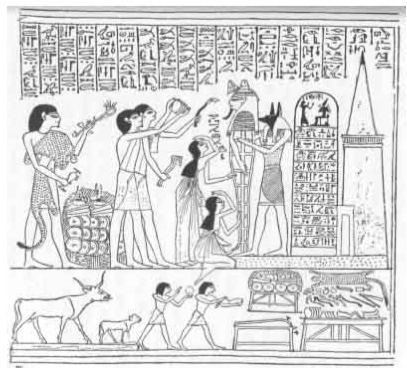Herodotus on E-Sagila
“181. This wall then which I have mentioned is as it were a cuirass for the town, and another wall runs round within it, not much weaker for defence than the first but enclosing a smaller space.
And in each division of the city was a building in the midst, in the one the king’s palace of great extent and strongly fortified round, and in the other the temple of Zeus Belos with bronze gates, and this exists still up to my time and measures two furlongs each way, being of a square shape: and in the midst of the temple is built a solid tower measuring a furlong both in length and in breadth, and on this tower another tower has been erected, and another again upon this, and so on up to the number of eight towers.
An ascent to these has been built running outside round about all the towers; and when one reaches about the middle of the ascent one finds a stopping-place and seats to rest upon, on which those who ascend sit down and rest: and on the top of the last tower there is a large cell, and in the cell a large couch is laid, well covered, and by it is placed a golden table: and there is no image there set up nor does any human being spend the night there except only one woman of the natives of the place, whomsoever the god shall choose from all the woman, as say the Chaldeans who are the priests of this god.
182. These same men say also, but I do not believe them, that the god himself comes often to the cell and rests upon the couch, as happens likewise in the Egyptian Thebes according to the report of the Egyptians, for there also a woman sleeps in the temple of the Theban Zeus (and both these women are said to abstain from commerce with men), and as happens also with the prophetess of the god in Patara of Lykia, whenever there is one, for there is not always an Oracle there, but whenever there is one, then she is shut up during the nights in the temple within the cell.
183. There is moreover in the temple at Babylon another cell below, wherein is a great image of Zeus sitting, made of gold, and by it is placed a large table of gold, and his footstool and seat are of gold also; and, as the Chaldeans reported, the weight of the gold of which these things are made is eight hundred talents.
Outside this cell is an altar of gold; and there is also another altar of great size, where full-grown animals are sacrificed, whereas on the golden altar it is not lawful to sacrifice any but young sucklings only: and also on the larger altar the Chaldeans offer one thousand talents of frankincense every year at the time when they celebrate the feast in honour of this god.
There was moreover in these precincts still remaining at the time of Cyrus, a statue twelve cubits high, of gold and solid. This I did not myself see, but that which is related by the Chaldeans I relate. Against this statue Dareios the son of Hystaspes formed a design, but he did not venture to take it: it was taken however by Xerxes the son of Dareios, who also killed the priest when he forbade him to meddle with the statue. This temple, then, is thus adorned with magnificence, and there are also many private votive-offerings.”
G.C. Macaulay, trans., The History of Herodotus, 1890, pp. Book 1, Clio, 180.


